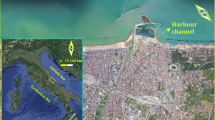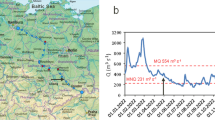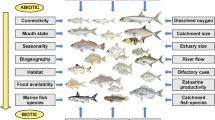Abstract
Estuaries are subject to extensive morphological changes through human activities, such as deepening and narrowing via dredging and channelization. The estuary sediment load, characterised by the estuarine turbidity maximum (ETM), can severely increase in response to channel deepening, shifting the estuary from a natural to hyperturbid state. The main processes driving the estuarine circulation, hydrology and sediment dynamics are relatively well known. However, their relative influence on suspended sediment concentration (SSC), as well as their role in the transition toward hyperturbid estuaries, is still a subject of debate. Therefore, this study aims at investigating the relative contribution of key estuarine drivers (gravitational circulation and tidal pumping mechanisms) on the ETM dynamics under significant estuary morphological changes. In a 3D numerical model of the Seine Estuary (France), three bathymetries from the last 50 years (1960, 1975 and 2010) were implemented, characterising the gradual estuary deepening and narrowing. The morphological changes induce an expected tidal amplification in the main channel, associated with a decrease of the tidal duration asymmetry. The salinity front slightly migrates up-estuary and the stratification strengthens, resulting in a higher and upper-estuary SSC distribution. Starting from a dominantly natural system driven by the tidal pumping mechanism in 1960, the contribution of the gravitational circulation strongly increased in the present-day anthropogenically-controlled system. Contrastingly, the maximum ETM mass barely changes with the morphological changes and dredging activities have hardly any influence. Hence, the maximum ETM mass in the Seine Estuary would principally result from the tidal forcing rather than the morphology.












Similar content being viewed by others
References
Allen GP, Salomon J, Bassoullet P, Du Penhoat Y, De Grandpre C (1980) Effects of tides on mixing and suspended sediment transport in macrotidal estuaries. Sediment Geol 26:69–90
Amoudry LO, Ramirez-Mendoza R, Souza AJ, Brown JM (2014) Modelling-based assessment of suspended sediment dynamics in a hypertidal estuarine channel. Ocean Dyn 64:707–722. https://doi.org/10.1007/s10236-014-0695-8
Avoine J, Allen G, Nichols M, Salomon J, Larsonneur C (1981) Suspended-sediment transport in the Seine Estuary, France: effect of man-made modifications on estuary—shelf sedimentology. Mar Geol 40:119–137
Becker M, Schrottke K, Bartholomä A, Ernstsen V, Winter C, Hebbeln D (2013) Formation and entrainment of fluid mud layers in troughs of subtidal dunes in an estuarine turbidity zone. J Geophys Res: Oceans 118:2175–2187. https://doi.org/10.1002/jgrc.20153
Bi Q, Toorman EA (2015) Mixed-sediment transport modelling in Scheldt estuary with a physics-based bottom friction law. Ocean Dyn 65:555–587. https://doi.org/10.1007/s10236-015-0816-z
Brenon I, Le Hir P (1999) Modelling the turbidity maximum in the seine estuary (France): identification of formation processes. Estuar Coast Shelf Sci 49:525–544
Burchard H, Hetland RD (2010) Quantifying the contributions of tidal straining and gravitational circulation to residual circulation in periodically stratified tidal estuaries. J Phys Oceanogr 40:1243–1262
Burchard H, Schuttelaars H, Ralston D (2018) Sediment trapping in estuaries. Annu Rev Mar Sci 10:371–395
Chernetsky AS, Schuttelaars HM, Talke SA (2010) The effect of tidal asymmetry and temporal settling lag on sediment trapping in tidal estuaries. Ocean Dyn 60:1219–1241
Cugier P, Le Hir P (2002) Development of a 3D hydrodynamic model for coastal ecosystem modelling. Application to the plume of the Seine River (France). Estuar Coast Shelf Sci 55:673–695
de Jonge VN, Schuttelaars HM, van Beusekom JE, Talke SA, de Swart HE (2014) The influence of channel deepening on estuarine turbidity levels and dynamics, as exemplified by the Ems estuary. Estuar Coast Shelf Sci 139:46–59
Deloffre J, Lafite R, Lesueur P, Lesourd S, Verney R, Guézennec L (2005) Sedimentary processes on an intertidal mudflat in the upper macrotidal seine estuary, France. Estuar Coast Shelf Sci 64:710–720. https://doi.org/10.1016/j.ecss.2005.04.004
Deloffre J, Verney R, Lafite R, Lesueur P, Lesourd S, Cundy AB (2007) Sedimentation on intertidal mudflats in the lower part of macrotidal estuaries: sedimentation rhythms and their preservation. Mar Geol 241:19–32. https://doi.org/10.1016/j.margeo.2007.02.011
Dickhudt PJ, Friedrichs CT, Schaffner LC, Sanford LP (2009) Spatial and temporal variation in cohesive sediment erodibility in the York River estuary, eastern USA: a biologically influenced equilibrium modified by seasonal deposition. Mar Geol 267:128–140
Donker JJ, de Swart HE (2013) Effects of bottom slope, flocculation and hindered settling on the coupled dynamics of currents and suspended sediment in highly turbid estuaries, a simple model. Ocean Dyn 63:311–327
Dronkers J (1986) Tide-induced residual transport of fine sediment physics of shallow estuaries and bays 228–244
Dyer KR (1973) Estuaries: a physical introduction
Friedrichs C, Armbrust B, De Swart H (1998) Hydrodynamics and equilibrium sediment dynamics of shallow, funnel-shaped tidal estuaries physics of estuaries and coastal seas 315–327
Friedrichs CT (2010) Barotropic tides in channelized estuaries contemporary issues in estuarine physics 27–61
Geyer WR (1993) The importance of suppression of turbulence by stratification on the estuarine turbidity maximum. Estuaries 16:113–125
Geyer WR, MacCready P (2014) The estuarine circulation. In: Davis SH, Moin P (eds) Annual review of fluid mechanics, Vol 46. Annual review of fluid mechanics. Annual reviews, Palo Alto, pp 175–197. https://doi.org/10.1146/annurev-fluid-010313-141302
Gibson R, England G, Hussey M (1967) The theory of one-dimensional consolidation of saturated clays: 1. Finite non-linear consolidation of thin homogeneous layers. Geotechnique 17:261–273
Glangeaud L (1938) Transport et sédimentation dans l’estuaire et à l’embouchure de la Gironde. Caractères pétrographiques des formations fluviatiles, saumâtres, littorales et néritiques. Bulletin de la Societe Geologique de France, Paris 7:599–630
Grasso F, Le Hir P, Bassoullet P (2015) Numerical modelling of mixed-sediment consolidation. Ocean Dyn 65:607–616
Grasso F, Verney R, le Hir P, Thouvenin B, Schulz E, Kervella Y, Khojasteh Pour Fard I, Lemoine JP, Dumas F, Garnier V (2018) Suspended sediment dynamics in the macrotidal seine estuary (France): 1. Numerical modeling of turbidity maximum dynamics. J Geophys Res: Oceans 123:558–577. https://doi.org/10.1002/2017JC013185
Guézennec L (1998) Hydrodynamique et transport en suspension du matériel particulaire fin dans la zone fluviale d’un estuaire macrotidal: l’exemple de l’estuaire de la Seine (France). Rouen
Jalón-Rojas I, Schmidt S, Sottolichio A (2015) Turbidity in the fluvial Gironde Estuary (southwest France) based on 10-year continuous monitoring: sensitivity to hydrological conditions. Hydrol Earth Syst Sci 19:2805–2819. https://doi.org/10.5194/hess-19-2805-2015
Jalón-Rojas I, Schmidt S, Sottolichio A, Bertier C (2016) Tracking the turbidity maximum zone in the Loire Estuary (France) based on a long-term, high-resolution and high-frequency monitoring network. Cont Shelf Res 117:1–11. https://doi.org/10.1016/j.csr.2016.01.017
Jay D, Musiak J (1994) Particle trapping in estuarine turbidity maxima. J Geophys Res 99:446–420
Landemaine V (2016) Erosion des sols et transferts sédimentaires sur les bassins versants de l’Ouest du Bassin de Paris: analyse, quantification et modélisation à l’échelle pluriannelle
Lanzoni S, Seminara G (1998) On tide propagation in convergent estuaries. J Geophys Res: Oceans 103:30793–30812
Lazure P, Dumas F (2008) An external–internal mode coupling for a 3D hydrodynamical model for applications at regional scale (MARS). Adv Water Resour 31:233–250
Le Hir P, Cayocca F, Waeles B (2011) Dynamics of sand and mud mixtures: a multiprocess-based modelling strategy. Cont Shelf Res 31:S135–S149. https://doi.org/10.1016/j.csr.2010.12.009
Le Hir P et al (2001) Fine sediment transport and accumulations at the mouth of the Seine Estuary (France). Estuaries 24:950–963
Le Hir P, Silva Jacinto R (2007) Currents, waves and tides: water movements, vol Booklet N°2 of the Seine-Aval programme, Quae ed., 31p
Le Hir P, Thouvenin B (1994) Mathematical modelling of cohesive sediment and particulate contaminants transport in the Loire Estuary Olsen & Olsen, Fredensborg, Denmark 71–78
Lesourd S, Lesueur P, Fisson C, Dauvin J-C (2015) Sediment evolution in the mouth of the Seine estuary (France): a long-term monitoring during the last 150 years Comptes Rendus Geoscience
Marmin S, Dauvin JC, Lesueur P (2014) Collaborative approach for the management of harbour-dredged sediment in the Bay of Seine (France). Ocean Coastal Manag 102:328–339. https://doi.org/10.1016/j.ocecoaman.2014.10.012
Mengual B, Hir P, Cayocca F, Garlan T (2017) Modelling fine sediment dynamics: towards a common Erosion law for fine sand, mud and mixtures. Water 9:564. https://doi.org/10.3390/w9080564
Morris A, Mantoura R, Bale A, Howland R (1978) Very low salinity regions of estuaries: important sites for chemical and biological reactions. Nature 274:678–680
Nichols FH, Cloern JE, Luoma SN, Peterson DH (1986) The modification of an estuary. Science (Washington) 231:567–573
Nidzieko N, Ralston D (2012) Tidal asymmetry and velocity skew over tidal flats and shallow channels within a macrotidal river delta. J Geophys Res Oceans 117
Nidzieko NJ (2010) Tidal asymmetry in estuaries with mixed semidiurnal/diurnal tides. J Geophys Res Oceans 115
Partheniades E (1965) Erosion and deposition of cohesive soils. J Hydraul Div 91:105–139
Postma H (1961) Transport and accumulation of suspended matter in the Dutch Wadden Sea. Neth J Sea Res 1:148–190
Schulz E, Grasso F, Le Hir P, Verney R, Thouvenin B (2018) Suspended sediment dynamics in the macrotidal Seine Estuary (France): 2. Numerical modeling of sediment fluxes and budgets under typical hydrological and meteorological conditions. J Geophys Res: Oceans 123:578–600. https://doi.org/10.1002/2016JC012638
Scully ME, Friedrichs CT (2007) Sediment pumping by tidal asymmetry in a partially mixed estuary. J Geophys Res Oceans 112
Sommerfield CK, Wong KC (2011) Mechanisms of sediment flux and turbidity maintenance in the Delaware Estuary. J Geophys Res Oceans 116. https://doi.org/10.1029/2010jc006462
Sottolichio A, Le Hir P, Castaing P (2000) Modeling mechanisms for the stability of the turbidity maximum in the Gironde estuary, France. Proc Mar Sci 3:373–386
Talke SA, de Swart HE, Schuttelaars H (2009) Feedback between residual circulations and sediment distribution in highly turbid estuaries: an analytical model. Cont Shelf Res 29:119–135
Toublanc F, Brenon I, Coulombier T (2016) Formation and structure of the turbidity maximum in the macrotidal Charente estuary (France): influence of fluvial and tidal forcing. Estuar Coast Shelf Sci 169:1–14. https://doi.org/10.1016/j.ecss.2015.11.019
Uncles R (2002) Estuarine physical processes research: some recent studies and progress. Estuar Coast Shelf Sci 55:829–856
Van Leussen W (1994) Estuarine macroflocs and their role in fine-grained sediment transport. Ministry of Transport, Public Works and Water Management, National Institute for Coastal and Marine Management (RIKZ)
Van Maren D, Winterwerp J (2013) The role of flow asymmetry and mud properties on tidal flat sedimentation. Cont Shelf Res 60:S71–S84
van Maren DS, Winterwerp JC, Vroom J (2015) Fine sediment transport into the hyper-turbid lower Ems River: the role of channel deepening and sediment-induced drag reduction. Ocean Dyn 65:589–605. https://doi.org/10.1007/s10236-015-0821-2
Verney R, Deloffre J, Brun-Cottan JC, Lafite R (2007) The effect of wave-induced turbulence on intertidal mudflats: impact of boat traffic and wind. Cont Shelf Res 27:594–612. https://doi.org/10.1016/j.csr.2006.10.005
Winterwerp JC (2011) Fine sediment transport by tidal asymmetry in the high-concentrated Ems River: indications for a regime shift in response to channel deepening. Ocean Dyn 61:203–215
Winterwerp JC, Wang ZB (2013) Man-induced regime shifts in small estuaries—I: theory. Ocean Dyn 63:1279–1292
Winterwerp JC, Wang ZB, van Braeckel A, van Holland G, Kösters F (2013) Man-induced regime shifts in small estuaries—II: a comparison of rivers. Ocean Dyn 63:1293–1306
Funding
This study has been carried out in the framework of the ANPHYECO project funded by the scientific research programme Seine-Aval V. Nicolas Chini (ACRI-HE) and Jean-Philippe Lemoine (GIPSA, MESSCENE project) are warmly acknowledged for providing the 1960 and 1975 bathymetry configurations.
Author information
Authors and Affiliations
Corresponding author
Additional information
Responsible Editor: Francisco Pedocchi
This article is part of the Topical Collection on the 14th International Conference on Cohesive Sediment Transport in Montevideo, Uruguay 13-17 November 2017
Rights and permissions
About this article
Cite this article
Grasso, F., Le Hir, P. Influence of morphological changes on suspended sediment dynamics in a macrotidal estuary: diachronic analysis in the Seine Estuary (France) from 1960 to 2010. Ocean Dynamics 69, 83–100 (2019). https://doi.org/10.1007/s10236-018-1233-x
Received:
Accepted:
Published:
Issue Date:
DOI: https://doi.org/10.1007/s10236-018-1233-x




